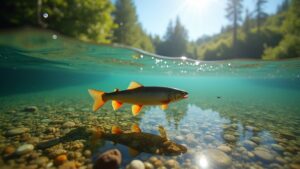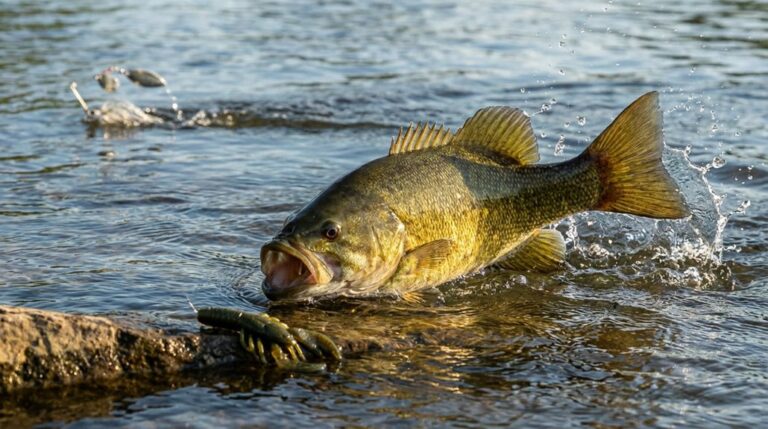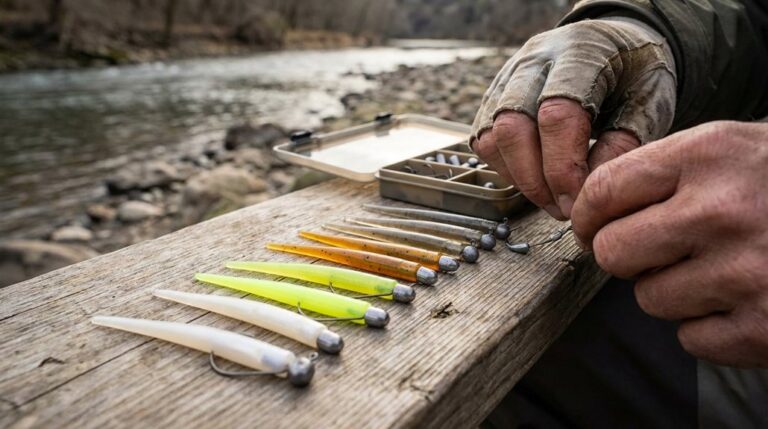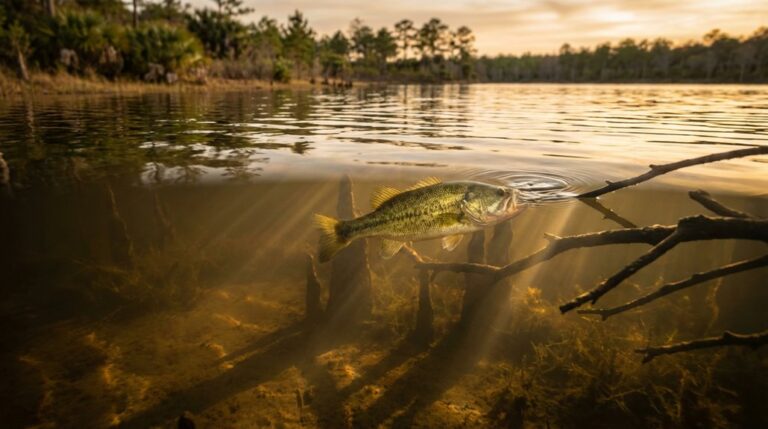Water clarity shapes where and how fish hunt, so you’ll want to match tactics to visibility. Particles from rain, wind, or tides cut sight, shifting fish to rely more on smell and their lateral line; clear water makes vision dominant and fish more wary. Use natural, subtle presentations in clear water and louder, high-contrast or vibrating lures in stained or murky water. Watch light angle, tides, and seams for feeding fish—you’ll find more specifics ahead.
Important Takeaways
- Water clarity shifts with runoff, wind, and tides, strongly affecting fish reliance on vision versus other senses.
- In clear water fish use sight more, favoring natural colors, stealthy presentation, and smaller profiles.
- Murky water reduces vision, so fish respond better to vibration, noise, and high-contrast, bold lures.
- Stained or mixing-zone water provides mid-visibility where contrast, silhouette, and louder retrieves attract predators.
- Time of day, sun angle, and polarized lenses control sight-fishing windows and how readily fish see your lure.
What Water Clarity Really Means for Anglers
Ever wondered how much the water itself decides your chances at the next cast? You’ll read water clarity as a mix of sediment, algae, and organic matter that shifts with rain, runoff, and wind. Visibility dictates strategy: clear water (about five feet or more) favors sight fishing but raises fish wariness, so you’ll use subtle presentations and natural colors.
In murky water, perception relies less on sight and more on smell and lateral line cues, so bolder, noisier lures win. Stained water gives intermediate visibility, letting you experiment with higher-contrast colors and louder retrieves. Watch mixing zones where differing clarities meet—they concentrate prey and predators.
Late-summer sun angles, wind, and temperature will further tweak how easily you spot and trigger fish. Many anglers also pair visibility-aware tactics with gear designed for cold conditions, like freeze-proof tip-ups with telescoping flags to maintain bite detection in adverse weather.
How Turbidity and Suspended Particles Form
How do tiny particles turn clear water cloudy? You see turbidity rise when rain and runoff wash soil and organic matter into streams and coastal zones, introducing sediment and other suspended particles. Wave action and wind stir bottom sediment and plankton back into the water column, so turbidity often spikes even after rain stops.
Levels vary with depth and distance from shore: shallow, wind-exposed areas hold more suspended particles than offshore waters. Those particles cause light scattering, reducing underwater visibility and changing how fish hunt and avoid predators. As turbidity increases, you’ll notice species relying less on sight and more on vibration or other senses, altering feeding behavior and the effectiveness of sight-based anglers. Spawning success often declines in turbid waters because eggs and developing fry require well-oxygenated gravel and clean substrate to survive.
The Role of Light Angle and Weather on Visibility
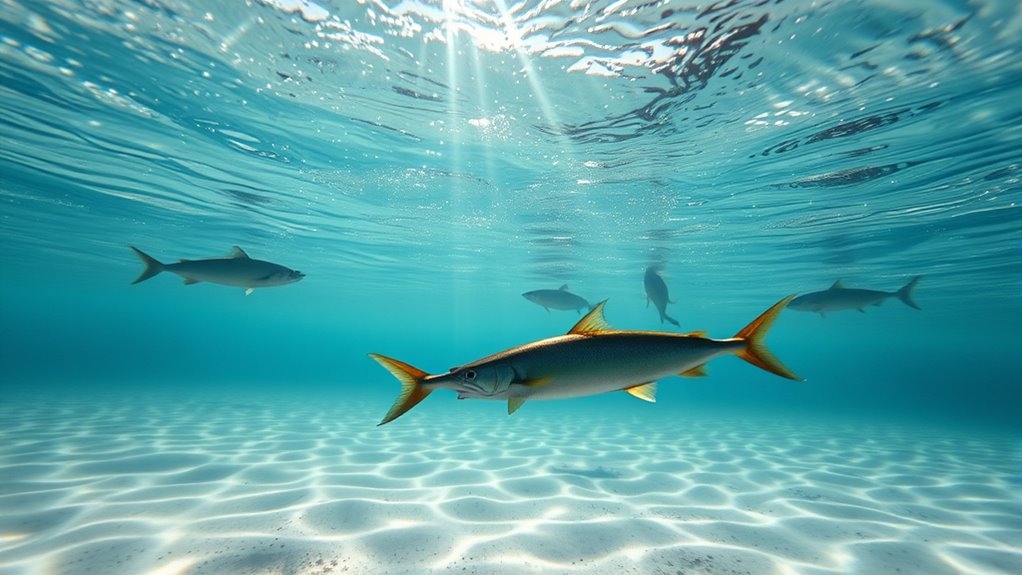
When the sun climbs high between about 10 AM and 2 PM, you’ll get the best sight-fishing window because the steeper light angle cuts surface glare and lets you see deeper into the water column. You should wear polarized sunglasses with brown or copper lenses to further reduce glare and boost visibility. Remember that water clarity isn’t static: overcast skies or drizzle lower light penetration, especially in shallow flats, so your effective sight fishing window shifts.
In late summer, clear water raises visibility but also the chance of spooking fish, so move quietly and cast beyond structure to draw fish into view. Always factor light angle and weather into where and when you fish to maximize sightings and minimize disturbances.
How Fish Senses Change With Water Clarity
Why should you change tactics as water clarity shifts? You rely on different sensing mechanisms as clarity changes: in clear water vision dominates, so natural lure colors and subtle action work best. In stained water you focus on contrast and silhouettes, choosing darker or brighter lures and bolder presentations. In murky water you depend on the lateral line’s ability to detect vibrations, so use noise-producing or vibrating lures to create detectable motion. Across clarity levels sight becomes less dominant while vibration and other cues grow in importance, so you’ll adapt lure colors, retrieve speed, and sound to match how bass sense their world. Fish activity also responds to weather-driven factors like temperature and pressure, so plan presentations around temperature shifts to match feeding windows.
| Clarity | Dominant Sense | Best lure approach |
|---|---|---|
| Clear | Vision | Natural colors, subtle moves |
| Stained | Sight+Contrast | Dark/bright, silhouette focus |
| Murky | Lateral line | Vibrating/noisy lures |
Bass and Flats Species: Behavior Across Clarity Levels
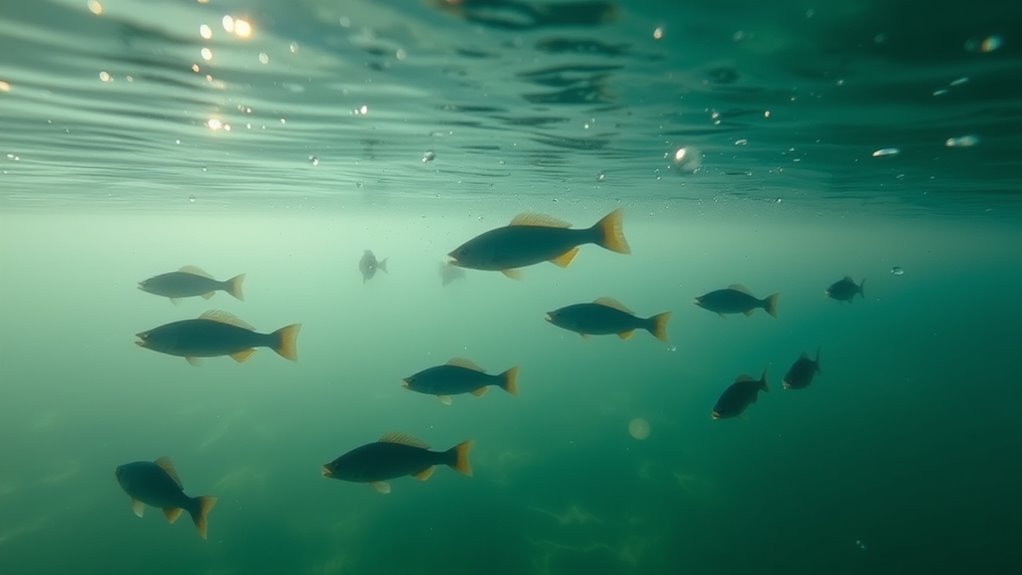
Curious how bass and flats species change tactics as water clarity shifts? You’ll notice bass behavior tied to visibility: in clear water they sit back and wait, relying on sight fishing and precise presentations; in stained water they’re bolder and move shallower; in murky water they hug structure and use their lateral line.
- Clear: target cover edges and weed lines, expect distance attacks.
- Stained: focus shallow structures, use higher-contrast lures with subtle rattles.
- Murky: fish tight to structure, employ vibration-heavy, noisy baits and slow retrieves.
Pay attention to ambush points shifting with visibility and adjust lure selection and retrieval speed accordingly. You’ll read fish sign faster and pick spots that match prevailing water clarity. The right gear can make a big difference on long days, so consider lightweight, durable reels like those with machined aluminum housings for comfort and corrosion resistance.
Lure Selection and Presentation for Clear Water
How should you tune your tackle for crystal-clear water? You’ll favor subtlety: water clarity demands lure presentation that mimics real prey, so choose natural colors and smaller profiles to avoid spooking wary fish. Use minimal splash on casts and a stealth approach when positioning—muskies spot anglers from far away in clear conditions. Because visibility is high, you can employ faster, occasionally erratic retrieves to trigger reaction bites; predators will visually follow and commit. Midday sun with polarized lenses enhances sight fishing, letting you pick targets and adjust presentation on the fly. Keep terminal tackle light but secure to preserve realistic action. In clear water, precision in color, size, retrieve speed, and angler concealment pays off. For those fishing saltwater and targeting larger species, consider a rod built with corrosion-resistant components to ensure durability and reliable performance.
Tactics and Lures That Work in Stained and Murky Water
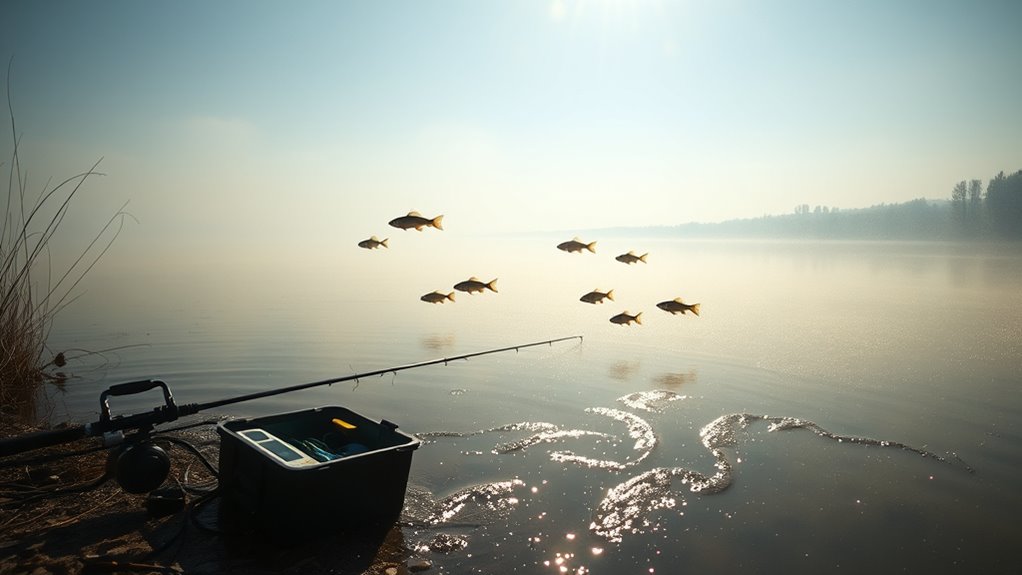
Want bites when visibility’s low? You adapt tactics for poor water clarity: rely on vibration fishing, loud lures, and targeted casts. In stained water, bass hunt by feel and sound, so choose noisy baits and work them deliberately. Cast near likely holding spots and use pauses to let predators locate the lure.
- Use spinnerbaits, chatterbaits, and lipless crankbaits for strong vibration and flash.
- Favor high-contrast colors (chartreuse, red, black) and retrieve near-bottom with occasional lifts.
- Prioritize near-structure casting to weed edges, fallen timber, and shore cover for ambush opportunities.
Slow, methodical presentations with pronounced vibration and water-displacing action will trigger strikes when sight’s unreliable. Kayak fishing’s stealthy approach and access to hidden spots can help you present these baits where pressured fish often hide.
Using Mixing Zones to Your Advantage
Ever notice where clear and murky water meet and the bait seems glued to the seam? You can use mixing zones to your advantage by reading water clarity and targeting concentrated prey distribution. Those seams often hold baitfish and attract predators like kahawai or marlin; you’ll adjust lure choice and presentation to visibility cues. Watch for salinity or temperature edges that create temporary barriers and predictable feeding windows. Position so your lure crosses the seam at likely depths, vary color and contrast, and retrieve to match fleeing prey. Use current to present baits naturally and note how clarity shifts with tide and runoff to time strikes. The seams are often found near weed lines and other structure that concentrates prey. Below is a quick reference for matching lure traits to zone conditions.
| Condition | Lure tip |
|---|---|
| Clear side | Subtle, natural color |
| Murky side | High-contrast, noisy |
Seasonal and Tidal Effects on Water Clarity and Bite Timing
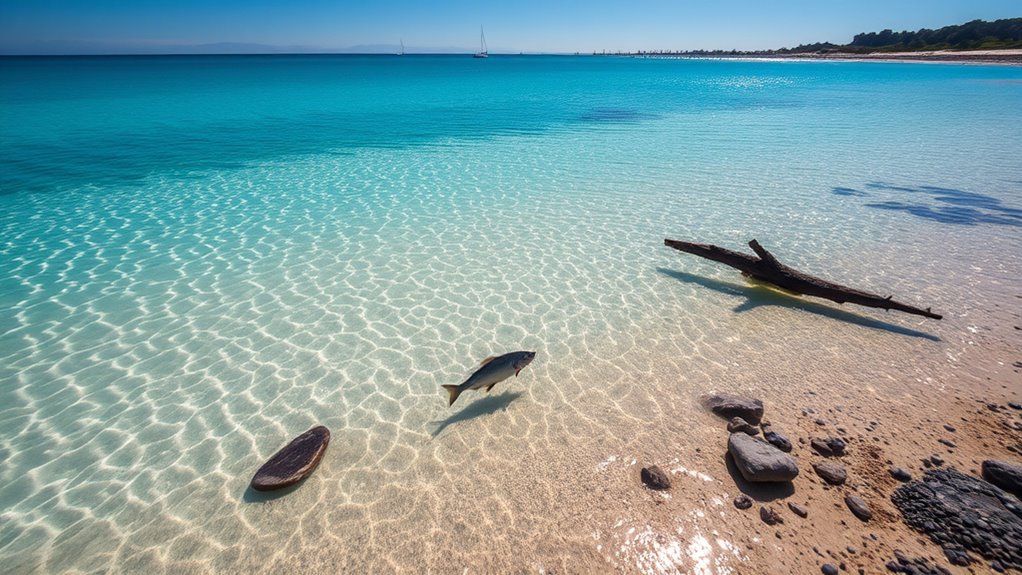
When should you expect visibility and bite windows to change? You’ll see shifts with seasonal runoff and tidal cycles: spring snowmelt and heavy rains muddy rivers and coastal flats, pushing bass from sight fishing to vibration-based feeding; post-storm clearing takes days to weeks and restores visual predation.
Warm, calm late-summer conditions often stabilize water clarity, widening sight-fishing opportunities on shallow flats. Tides route clarity too—incoming tides can bring clearer water into shallows, while outgoing tides may pull turbidity from river mouths, altering bite timing.
- Watch recent rainfall and melt for murkier periods.
- Time outings around incoming tides for clearer water.
- Expect improved sight fishing after several dry, warm days.
Adjust lures and timing as clarity and tides change. Cape Cod’s diverse habitats, including extensive sand flats and tidal creeks, mean these effects are especially pronounced near sand flats, where the last hour of the dropping tide often concentrates feeding fish.
Gear and Stealth Techniques for Sight Fishing
A well-chosen setup and quiet approach make sight fishing far more productive, so start with polarized sunglasses (brown or copper lenses) to cut glare and reveal structure, and pick light, accurate tackle that lets you place lures precisely without spooking fish. You’ll get glare reduction that helps read water clarity and spot cruising fish, especially mid-day when sun angles favor visibility.
Use stealth techniques in late summer: approach low, avoid splashes, and cast from angles that keep sun reflection away from fish. Focus on precise lure presentation—short, accurate casts and slow, deliberate retrieves—to avoid line tension and false takes. Change angles and presentations until you find the strike zone without disturbing the fish. Consider wearing UPF 50+ sun-protective clothing to reduce your visibility and stay comfortable on long sight-fishing sessions.
Final Thoughts
You’ve learned how clarity shapes fish behavior and your tactics, from spotting mixing zones to matching lure presentation in stained or murky water. Remember to read light angle, weather, tides and seasons, and lean on scent, vibration and contrast when visibility drops. Stay stealthy with low-profile gear for sight fishing, and adapt retrieve speed and lure size as clarity changes. Practice reading conditions and you’ll consistently put more fish in the boat.

